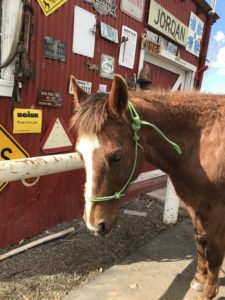(Mocha in one of her occasional hitching rail test moods)
Some mindful Facebook posts this morning about horses, turnout, and training made me think about my horse life and just how I’ve learned and grown as a horsewoman. One thing in common with teaching and horse life is that the learning never stops. Even if you own the same horse over fifteen years (Mocha and I hit our fifteenth year together in August), you still learn more and more about how that horse works and thinks as the years go by. Especially if you do what I did with Mocha, and put the horse through a dramatic change in management in an attempt to break an injury/illness cycle (from 24/7 stall life in a wet climate to 24/7 pasture life in a herd in a dry climate). I went into her current circumstances well aware that it might not work, and if it didn’t…well, I don’t think she would have lasted more than another year or two of life in a stall. But pasture life agrees with her, even though she is horribly needy and forms tight bonds with pasture companions. She will leave her friends easily, but frets if they are taken away from her. She’s healthy and is in good condition, and we could conceivably have another five to eight active years together if managed correctly. The me of fifty-some years ago would be boggled by the thought of what I’m now doing with a 20-year-old mare. And that is a reflection of how things have changed in that period for horse management.
I’ve never particularly thought that doing everything like I did when I was a kid with horses was particularly a good idea. For one thing, horse management these days, even with rough pasture boarding, is entirely different from what I grew up with. Regular dental work, corrective farriery, deworming products, fly management products are very different from what I had access to in the late 60s-early 70s (not so much vaccination protocols. The biggest changes in vax from then have been the addition of rabies and West Nile to the vax regime. I was an early adopter of the Venezuelan Equine Encephalitis vaccine when it first came out, in addition to the Eastern and Western variants as well as tetanus. Can’t remember if rhinovirus was also part of the mix then–but the point is, vax was something we just plain did and isn’t that different from today). The closest I came to corrective farriery was putting front shoes on a foundered horse to support her feet, and noticing that hey–the stumbling horse stopped stumbling (I suspect that she may have foundered after foaling before we bought her, therefore the stumbling. She grass foundered one spring with me years later and needed careful management after that). Dental work wasn’t in the cards, and deworming product (unless the vet came out and tubed the horse) was a powder added to grain that the Sparkle mare would manage to separate out and leave in a nice neat little pile in the middle of her grain box instead of a paste syringe. Horses were also considered old by their mid-teens in those days, especially for a non-showing, backyard owner. Grass founder was poorly understood in my area, and I dealt with it in a pony and a horse.
On the other hand, there were certain tips and tricks I learned then that I still use. Showmanship practice as a means to get the horse’s focus on me (shades of “playing horse show” with the green Shetland yearling under the supervision of my first horse mentor, plus learning that hey. The old Sparkle bitch mare started listening better to me when I practiced Showmanship with her in 4H). Ground driving/long-line work to condition and school without a rider at all three gaits in something other than a lunging circle. The use of the lunge as a schooling technique, not letting the horse careen wildly as a means to blow off energy. A habit of establishing a personal space bubble and enforcing it when working with horses in the stall or the field. How to assess a horse’s reliability to be ridden on a road, and how to safely train a reliable horse to be calm around cars and other vehicles. Asking a horse to respond to lighter and lighter cues while working in serpentines and circles. The well-trained muscle memory of how to stick on a horse blowing up under you, and the confidence to deal with challenging situations including knowing when and how to bail out safely. I’m an old, reasonably bold rider, but I have a lot of kid falls in my history that contributed to knowing my limits…mostly, in my sixties. But as I’ve discovered, I’m bolder than a lot of amateurs my age (well, excepting those who compete in jumping or eventing, but I don’t do those things).
All of these were sharpened by later experience with a well-regarded trainer, but the foundation was laid almost fifty years ago. 18 years with a professional supervising me who would also sit down and talk about training, showing, breeding, and the state of the horse industry put a polish on my understanding of work with horses. Those eighteen years with Gregg Shrake really challenged me, made me think about my process, and built on my early experiences. Before I bought Mocha, I spent a lot of time being one of the ammys who provided a reality check on a training horse’s progress as part of my lessons. I never was the first one up on a greenie, but several times I got in one of said greenie’s first 10 rides. I learned more about the nuances of show horse world, and played with it a little bit. Now I’m at a place where I’m learning about more sophisticated pasture and herd management techniques, as well as rodeo horse training and expectations, and mindful management of a small breeding operation focused on producing good-minded, good-tempered horses.
What I keep on learning with horses is that learning is always happening. And that even old horses and old women can learn how to do new things. My relationship with Mocha is not at all like the one I had with Sparkle–while with both mares we came to a position of mutual trust, Mocha is more standoffish and when we are done with working and attention, she is Done With People, while Sparkle was much more social. I’ve achieved more with Mocha than I ever did or could with Sparkle. Breeding and training counts, and Mocha has both. But both mares have taught me a lot, and the lessons are still coming.
Mocha makes sure of that.







